In the water wonderlandby Uwe Walz
Fishermen
|
||||||||||||||||||||||||||||||||
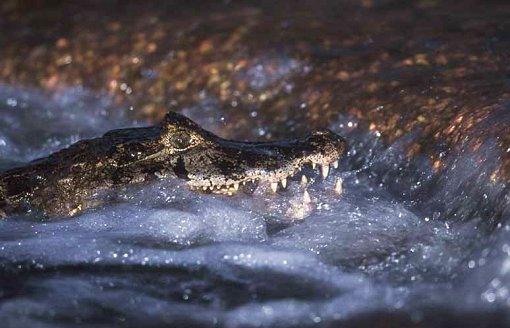 |
Cayman. Next to a bridge, under which a whirlpool had formed, the caymen gathered on a regular basis and waited with wide open jaws to catch the passing fish. The problem: the caymen did not start their hunting spree until after sunset. But with the twilight, enormous mosquito swarms suddenly appeared. Within minutes, I was so badly bitten, that I could hardly concentrate on the fishing caymen. Canon EOS-1, with EF 4.0/600mm, 1/30 sec, flash intesifyer, Fuji Sensia 100, tripod. |
|
Key-word Pantanal |
 |
“Sleeper tree”. With the last daylight still left, I discovered a “sleeper tree” with silver and satin herons. During the breaking twilight, more and more birds flew onto this tree. I waited until it was almost dark. A lake between the tree and myself prevented my getting closer. Canon EOS-1, EF 4.0/600 mm, 2 X converter, 1/30sec, Fuji Sensia 100, tripod. During longer closures you can use a four-Kilo bag of rice to eliminate any wobbling of the lens, which may be triggered through the camera´s mirror. |
|
Anhinga |
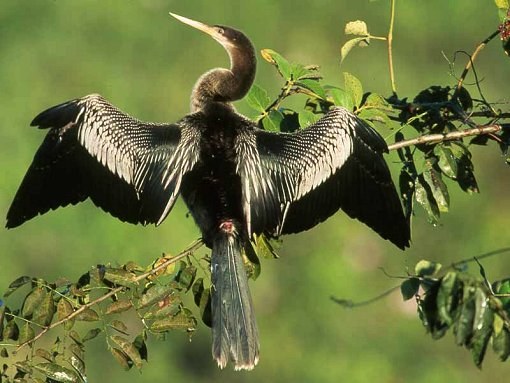 |
|
What has more to offer? The Pantanal is a superlativ habitat: the water wilderness is 240 000 square kilometers in size, located where the three countries, Brasil, Bolivia and Paraguay meet. As large as the state of Hessen. The largest part of the nature preserve is part of the brazilian states of Mato Grosso and Mato Grosso do Sul. Living in these marshlands, barely touched by humans, 650 species of birds, 250 types of fish, 80 different kinds of mammals and 50 species of reptillians exist. Besides the innumerable insects, there are more than 1000 different species of butterflys. From November through April, more than 6 months a year, the swamplands are under water. From a catchment area of more than 2 Million square kilometers, the waters of large and small rivers gather in the Pantanal to a great inland delta. During the dry seasons, sweet water lakes and lagunes are formed as the water retreats. Starting point for the Panatanal safari is Cuiabá, a city of millions of people. Next stop is the settlement of Poconé on the edge of the wildlife preserve. There is only a single access to get to the heart of the Pantanal and that is a clay dirt road with many huge potholes, at times 40 cm deep, the Transpanateira. This road ends after 150 kilometers at the Cuiabá river and you have to use the same way back out. 189 wooden bridges, partially rotted, turn this break-neck tour into an exciting adventure. Reward for the fear : unforgettable encounters with unusual animals, with giant Tukans, River and Giant Otters, Nandus, Howling Monkeys, Marsh Deer, Armadillos, the Great Ant Eater, Anakondas and maybe even a Jaguar. |
|
Hyacinth ara. Four days before the end of my Pantanal safari, we came upon a tree |
 |
|
|
Scissorbeaks. A few hundred black coated scissorbeaks were resting on an island |
|
Armadillo.I had positioned myself at an ideal distance for taking pictures and was |
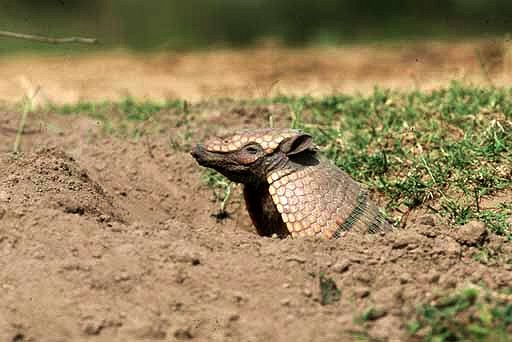 |
|
Great Anteater. Not until the fourth day, we discovered a great anteater. He was in |
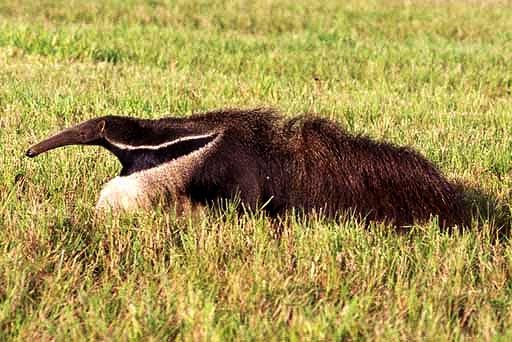 |
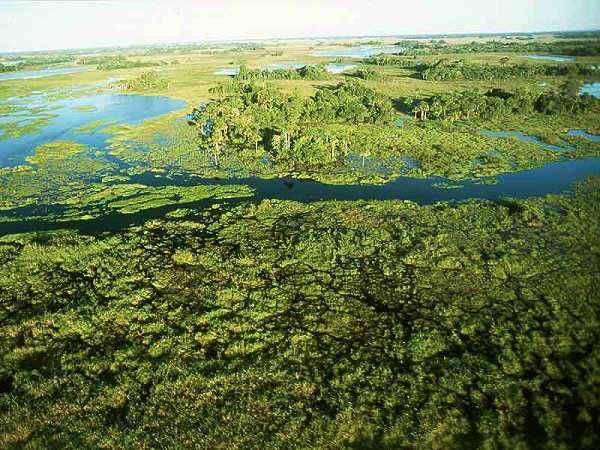
|
Waterworld. During rain season the shallow bowl of the Panatanal slowly fills with water. Leisurely the large wave moves toward the Ocean - the Rio Paraguay has a decline of appx. two to three cm per kilometer. A sensitive film and bright wide angle lens are the best prerequisites for aerial photos, that way you avoid transferring the vibrations of the airplane onto the picture. |
|
My Tour-suggestions
|
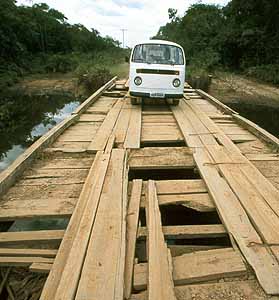 |
Travel - InformationSeason for travel. From a photographic point of view the dry periods from July until October is the best time to travel to/through the Panatanal. The grass savannas are mostly dry and the waterfowl concentrate on the rivers and lakes that are left, just like the Water Pigs and Caymen. Flights. Transatlantic flights with VARIG or Lufthansa from Frankfurt. Both airlines are connected through a code-share program. There is at least one aircraft which travels to Rio de Janeiro or Sáo Paulo a day. Price for a round trip ticket is appx. DM 1,700,- . Travel time Frankfurt - Sáo Paulo is 12 hours. From Rio or Sáo Paulo you continue on to either Campo Grande or Cuiabá. Currency. In 1994 Brasil changed to the “Real” and has its bearings on the US-Dollar: You pay DM 1.70 for one Real. Credit Cards, traveler checks and US-Dollars are accepted almost everywhere. Lodgings. Accomodations in the Panatanal are sparse. Some can only be reached by aircraft or boat. There are five lodges along the 145 Km long Transpanateira and the road ends as a dead end street. Since there is only one gas station on this road, it is advisable to gas up beforehand. You can transit the Transpanateira with a VW-Bus during the dry periods when the road is dry. In other areas you can´t move without a four-wheel-drive vehicle. There is a first-class lodge on the outskirts of the Panatanal, the Refugio Ecologico Cayman. 70 guests find space in four buildings/houses. There is a program to accompany the gauchos (Cowboys) when the herds are driven out of the Panatanal, besides the normal trips in back of a flat bed pick-up and boating tours. Also, the lodge offers guides that speak german. Clothing. Light summer clothes. Longarm shirts (because of the mosquitos and other insects); head gear, best with neck protection (against sunburn); a mosquito net is advisable. Travel equipment provider : “Globetrotter”, Wiesedamm 1, D-22305 Hamburg, Tel.: 040/291223 (Catalogue on request). |
|
Photo suggestionsLenses. My favorite lens is the 4.0/600 mm from Canon. Long focal lengths (400-600) with a high luminous intensity allow for pictures with a converter which expands the focal length by a factor 1.4 or 2. A high luminous intensity is very important for short closures since the pictures are shot mostly from the car on the Transpanateira. The car is also used as a camoflage or hidden tent. For fast action shots and pictures out of a moving boat I use a 4.0/300 - mm - telephoto lens with picture stabilizer, which replaces a tripod in many situations. Camera. I prefer a Canon EOS-1 with booster for fast picture frequency of up to six photos per second. The camera is especially robust and dependable and especially sealed against the dampness, rain and dust. Film. An allround film with good contrasting and excellent color saturation is the Fuji Sensia 100. With 100 ASA you can reach very short closure times even with telephoto lenses. This film is especially good for animal pictures. The Fujichrome Velvia 50 is first choice for me for landscape pictures: intense plastic colors which appear too loud at times. The Velvia tends to lean toward strong contrasts and fades too much into the shadows. The film requires some time to get accustomed to. I expose it with 40 ASA. Because of the large required deep focus with landscape pictures, I tend to need longer shutter times and work mostly with tripods. I expose appx. 350 films during a long haul journey of 3 weeks. |
Tripods. I take two tripods with me on every trip: a small lightweight one for landscape picutures; a large hydro tilt for smooth maneuvering while taking wildlife pictures. For weight reasons and a matter of stability, they are both made of carbon. Journeys far and wide. The biggest problem for wildlife photographers during flights to places far away is the transport of luggage and equipment. It is somewhat easier when flying to North America: your allowance are two suitcases at 32 kilos per bag and one piece of carry-on luggage. This is different on flights to Africa and South America: the allowance is one piece of carry-on and one 20 kilo suitcase for check in luggage, any additional piece or more than the 20 kilos allowed are charged with DM 65,- per kilo. The photo equipment of a photographer can weigh up to 40 kilos and more by itself. Recently it has become necessary to take the film material into the carry on luggage, to insure that they will not get damaged in the check in luggage by the X-ray machines. |
|
Further information. |
|
|
technical - Information
Films Converter Window tripod Booster or motor Carbon tripod Picture stabilizer |
|
| The animal photoschool Animal and nature photography |
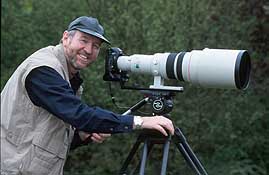 |
| Uwe Walz is a globetrotter in wildlife photography. The professional photographer from Hamburg is familiar with almost all of the animal paradise and nature preserves of the world. Books published: |